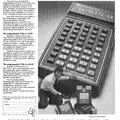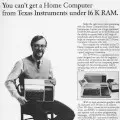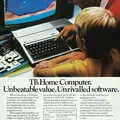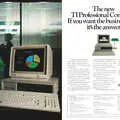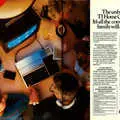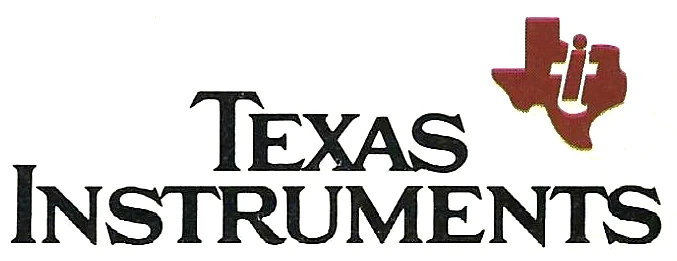
Texas Instruments Advert - July 1982
From Personal Computer World
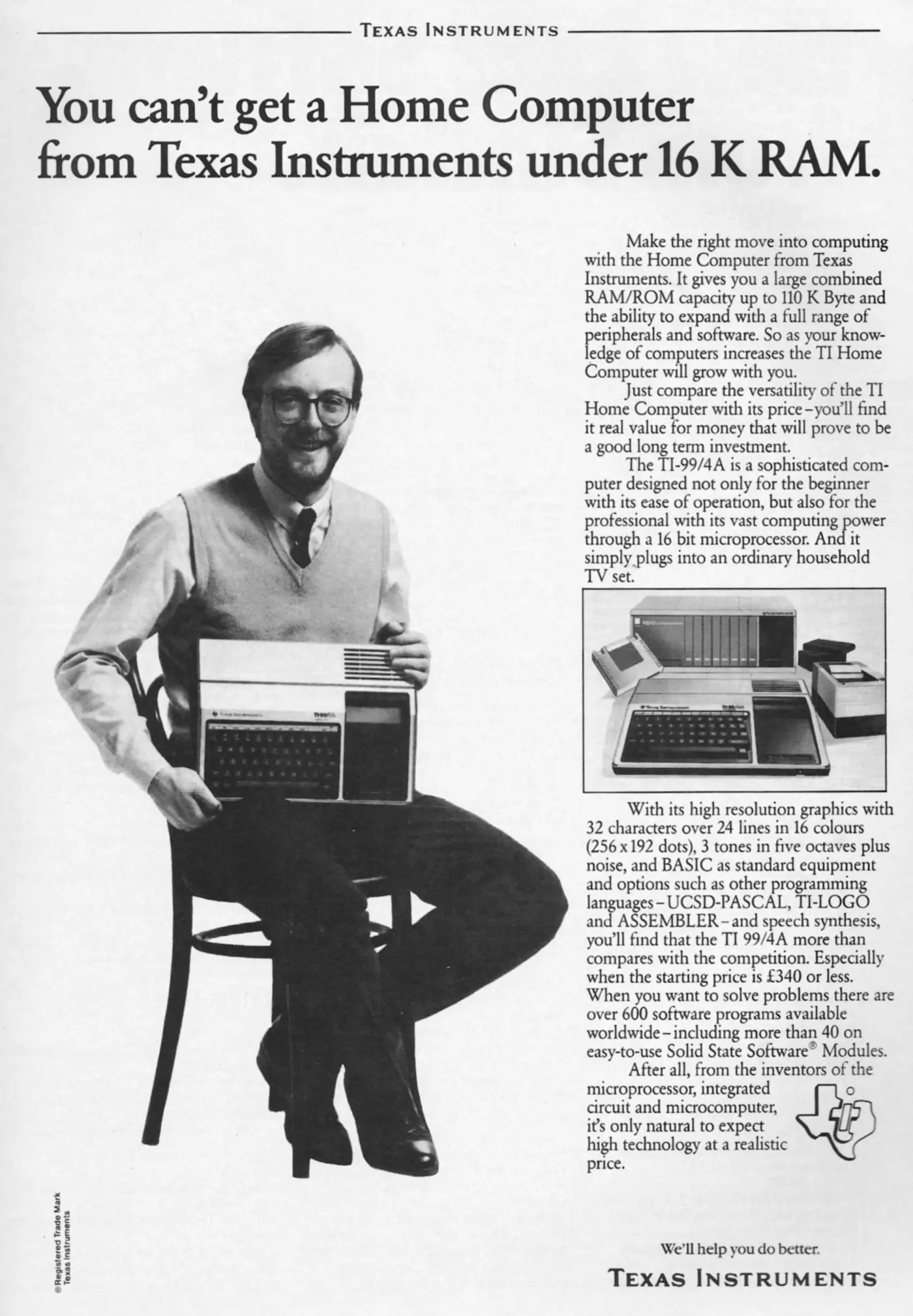
You can't get a home computer from Texas Instruments under 16K RAM
Here is an advert from the company that did quite a bit to shake up the 1970s calculator market, and in doing so caused Commodore to buy MOS Technology and with it the 6502, which led to the Commodore PET.
It shows a dude in a tank top - which might have been quite trendy in 1982, but it's doubtful - holding the TI-99/4A.
It had an unusual 16-bit processor in the shape of TI's own TMS9900 - a single-chip version of TI's own TI-990 minicomputer - and it could support up to 48K RAM. It was aimed at the home market, on account of its ability to plug in to a television.
It sold for £340 - about £1,630 in 2025 money, a slight face-value increase over the price of its previous version, the TI-99/4, although the earlier model had dropped in price massively from around £1,000 to only £295 in 1981 (£5,360 down to £1,580 in 2025 prices)[1].
Rumours of the appearance of the original TI-99/4 had started in 1978, when it was announced that "a giant in electronics was to produce a personal computer".
That company was revealed as Texas Instruments, which was already well known thanks to the fact that most TTL (Transisitor-Transistor Logic) integrated circuits of the time were all from TI, which according to Practical Computing meant that TI's TTL Data Book was generally accepted as the "Bible" amongst reference works on ICs and components.
Details began to emerge around Easter 1979, but by mid-1979, when the product had been seen in prototype form, the general opinion seemed to be that it was "a damp squib, a disappointment[2]". Rivals were no doubt relieved, as there had been talk of the very survival of other companies once TI got into the market.
The TI 99/4 finally launched in the UK around the spring of 1980, but the problem with it was that it only output video using the North American NTSC standard, so for the UK market it either required a modification to the user's PAL television, or more generally required that the micro came bundled with an actual television capable of handling both TV formats.
This meant that the price ranged from about £750 in 1980 (£4,750) including a black-and-white set, and up to £1,300 (£8,230) for a dual-standard colour TV with Viewdata.
As the review of the machine in May 1980's Personal Computer World concluded, "it certainly has a lot to offer [but] the question is - are people in the UK ready to spend this sort of money on a home computer?"[3].
For the first few years, the answer was broadly no, which remained true of the follow-up model, the TI 99/4A, which had at least fixed the issue of NTSC video output.
However, by the summer of 1982 the 99/4A's price was cut to first £315 and then £199 as the long-expected price war in the micro industry kicked off.
Often credited to Commodore's decision to drop the price of its VIC-20, the move also dragged in Atari as collateral damage, forcing it to drop the price of its Atari 400 from £300 to £200.
TI's marketing manager Irfan Salim claimed that a "a quickly developing UK market and resulting sales" had allowed TI to drop its price, before conceding that the competitive market in the UK had been "a major determining factor"[4].
A few months later Salim was reporting that the home computer market "had gone very quiet for TI". This coincided with TI offering a £50 cash rebate for its machine as an attempt to prop up sales in the run up to the all-important Christmas period.
The company had been faced with the choice of price cuts or heavy advertising, but figured a rebate was the quickest way to the customer - at least until it had decided whether or not to make the reduction permanent. According to Salim, the same tactic in the US had led to an eight-times increase in sales[5].
This advert is also a bit controversial in TI's claim to have invented the first microprocessor. Whilst TI had created the first "solid circuit" on the 12th September 1958[6], it wasn't a design that was practical to actually manufacture.
TI's first real IC was introduced in 1961, but meanwhile Fairchild Semiconductor's Robert Noyce[7] and a team of engineers had produced the first working monolithic integrated circuits in May 1960[8].
Noyce went on to co-found Intel, which is generally credited with the first commercially-available microprocessor - the Intel 4004, launched in 1971[9].
TI had already created the TMS 1000, however this was considered more of a microcontroller, and it wasn't commercially released until 1974[10].
According to that Wikipedia article "We may never know which company actually had the first working microprocessor running on the lab bench".
It was suggested that TI had thrown away a possible early lead in the micro market as companies which had seen three prototype micros that TI had developed had been impressed, and it was forecast that TI could dominate the industry within 18 months.
However TI apparently failed to release the two more powerful machines and messed around with the specification of the third, before announcing that actually it was going to design a completely new micro for the home market instead, but that it wouldn't be around for another two years.
The reason given was that this would all be too damaging to TI's profitable mini-computer business, a conclusion which didn't go down well with their head of the micro project - Robb Wilmot - who resigned and came over to the UK, becoming MD of ICL two years later in 1981[11], where he turned the bankrupt 33,000-employee behemoth in to a success[12].
The design of the eventual machine was also driven by a corporate requirement to use as many of TI's own chips as possible, including the central processor.
Whilst there had been a European-designed prototype known as "Mojo", which was built around TI's own version of the Intel 8080A, this was still seen as not TI enough and so the decision was taken to switch to the more expensive TMS9900.
This chip required larger - and custom - packaging compared to most other chips of the day, plus it needed its own custom support chips, as most available chips of the time were built around 8-bit architectures.
Also, thanks to its minicomputer heritage, it did unusual things with registers. There were an unusually-large number of these, but they were stored in an area of off-chip "scratch" memory. Whilst quicker than RAM, it was still slower than on-chip registers and so performance suffered.
It also suffered because its architecture - although 16-bit - only provided 16 bits of address space, which meant it could address only 216 bits of memory, or 65535 bytes. This happens to be the same as the 8-bit processors of the day like the 6502 or the Z80, so the TMS9900 offered no memory benefit either[13].
Even Intel's hobbled 8088 processor - as would be used in the IBM PC - offered 20 bits, which allowed up to 1MB of memory.
Perhaps in order to encourage demand for the chip, TI launched a single board version of its TM990 minicomputer - called the TM990/189M - in the summer of 1979. Using the same TMS9900 processor as the TI-99/4, the board actually came with punched holes which meant it would fit into a ring binder.
It also came with a built-in keyboard, identical to that of TI's TI-58 and TI-59 programmable calculators, plus a 10-digit seven-segment calculator-like display, which Practical Computing reckoned was "not all it could be but you get used to it quickly and learn to recognise the letters".
It retailed for £256 - about £1,830 in 2025 money[14].
Meanwhile, despite the somewhat botched introduction of the TI-99/4 - at least in the UK - and the frequent negative reviews, the constant price-cutting did work to TI's advantage, in terms of sales at least, with the machines eventually shifting around 2.8 million units.
It was said though that TI lost money on every computer it sold, which led it to a $330 million write-off before it existed the home-computer industry in 1984[15].
Despite being the world's first 16-bit home computer, and selling in quantities that some other micro companies could only dream of, the TI99/4A could never quite shake off its reputation as an "embarrassing failure".
Date created: 01 July 2012
Last updated: 06 August 2025
Hint: use left and right cursor keys to navigate between adverts.
Sources
Text and otherwise-uncredited photos © nosher.net 2025. Dollar/GBP conversions, where used, assume $1.50 to £1. "Now" prices are calculated dynamically using average RPI per year.
